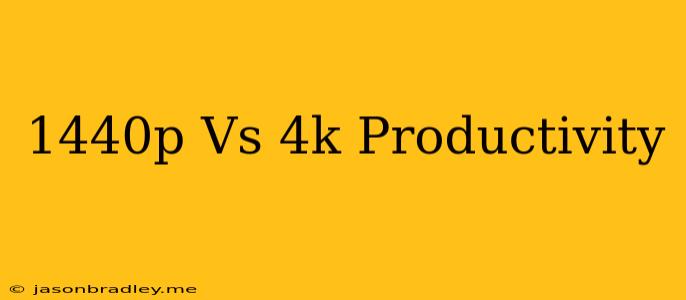1440p vs. 4K for Productivity: Which Resolution Reigns Supreme?
Choosing the right monitor resolution can significantly impact your productivity. While 4K displays are often touted as the ultimate choice, 1440p offers a compelling alternative, especially for productivity-focused users. This article delves into the pros and cons of both resolutions, helping you decide which is the better fit for your workflow.
1440p: The Sweet Spot for Productivity?
Pros:
- Sharper than 1080p: 1440p offers a noticeable improvement in clarity over 1080p, resulting in a more immersive and detailed viewing experience.
- More affordable: 1440p monitors are generally more affordable than 4K monitors, making them a more accessible option for budget-conscious users.
- Less demanding on your hardware: 1440p requires less processing power than 4K, allowing for smoother performance, especially on older or less powerful systems.
Cons:
- Lower resolution than 4K: While sharper than 1080p, 1440p still falls short of the pixel density offered by 4K. Some users may find the difference in sharpness noticeable, especially when working with high-resolution images or videos.
- May not be ideal for large screens: On larger monitors, the pixel density of 1440p may not be as impressive, leading to a less immersive experience.
4K: The High-Resolution Champion
Pros:
- Exceptional detail and clarity: 4K offers a truly stunning visual experience with incredibly sharp detail and clarity. This is especially beneficial for tasks that involve working with intricate graphics, high-resolution images, or videos.
- More screen real estate: 4K displays provide a significantly larger canvas compared to 1440p, allowing for more windows, applications, and content to be displayed simultaneously.
- Future-proof: As technology continues to advance, 4K is likely to become the standard resolution for many devices. Investing in a 4K monitor now will ensure you are well-equipped for the future.
Cons:
- High cost: 4K monitors are generally more expensive than 1440p monitors, making them a significant investment.
- More demanding on hardware: To fully utilize a 4K monitor, you need a powerful graphics card and processor. This can be a costly upgrade for users with older or less powerful systems.
- Scaling issues: Some applications and operating systems may not be fully optimized for 4K resolution, leading to scaling issues and blurry text.
Choosing the Right Resolution
The best resolution for you depends on your individual needs and preferences. Here are some factors to consider:
- Your budget: 1440p monitors are generally more affordable than 4K monitors.
- Your hardware: 4K monitors require more powerful hardware than 1440p monitors.
- Your monitor size: 1440p may not be as impressive on larger monitors, while 4K offers a truly immersive experience on larger screens.
- Your workload: If your work involves intensive graphic design, video editing, or other tasks that require high detail, 4K is the better choice. For general productivity tasks, 1440p offers a great balance of clarity, affordability, and performance.
Ultimately, the best way to choose the right resolution is to test both options and see which one you prefer. You can also consider purchasing a monitor with multiple resolution options, allowing you to switch between 1440p and 4K as needed.
